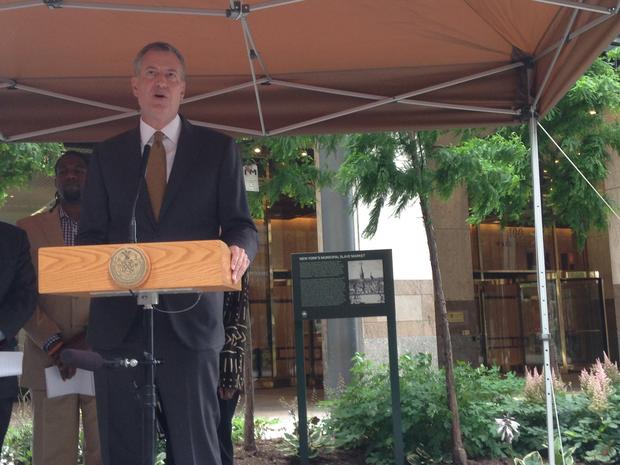
New York City just made a confession about its slave-holding past.
Mayor Bill de Blasio, first lady Chirlane McCray, and city officials gathered on Saturday at the corner of Wall and Water Streets to mark the spot of an 18th century slave market that was sanctioned by the city. They unveiled a historical marker describing how New York's Common Council — a precursor to the City Council — founded the market, and that it "auctioned enslaved people of African ancestry." The marker goes on to confess, in the sense of clearly admitting to past misdeeds, that city businesses, and the city itself, made vast sums of money from the slave trade.
"It was a vile, vile trade that persisted for more than 50 years right here," Mayor Bill deBlasio said at a ceremonial unveiling of the marker. "You could come here any day and see it happening and, somehow, it was considered normal in this city."
Generally speaking, the extent and commonplace nature of slavery in New York is not well known. Slavery began in Manhattan in 1626, when the island was governed by the Dutch and called New Amsterdam. Slaves cleared forest land to pave the way for the earliest version of Broadway. They also helped build the wall that Wall Street is named for.
Slavery was deeply embedded in local life. The marker notes that "by the mid-18th century, approximately one in five people living in New York City was enslaved and almost half of Manhattan households included at least one slave." The Wall Street slave market flourished under such circumstances; it persisted on what used to be the Lower Manhattan waterfront from 1711 to 1762.
But the city profited from the slave trade far beyond the exploitation of free labor.
New York financial firms provided much of the capital and expertise that kept the slave system running: they bankrolled Southern plantations, insured slaves as property, and used them as collateral for loans. And countless companies thrived within New York's role as a major hub in the Triangular Trade, which sent slaves and the goods they produced in a constant flow around the Atlantic Ocean from England to Africa to North America.
New York State abolished slavery in 1827, but companies in New York City kept accruing wealth from slavery until the end of the Civil War. For example, the Domino Sugar Factory in Brooklyn refined sugar cane and molasses produced by slaves in the Caribbean.
Mayor deBlasio stood near the spot of the former Wall Street slave market and said that though no one alive could be blamed for the wrongs that occurred there, it was still right to recall them. He said that by marking and honoring those people whose time on earth "literally did not belong to them," the city was sending a message that might resonate today.
"Black lives matter," he said. "It's a simple concept — one we shouldn't have to delineate but one that we need to because of the stains on American history."
(WNYC previously broke the story about the marker's installation and the history behind it.)

